Page 38 of 484

38
1-2. Opening, closing and locking the doors and trunk lid
■Operation signals
Doors: A buzzer sounds and the hazard warning flashers flash to indicatethat the doors have been locked/unlocked. (Locked: once;
Unlocked: twice)
Trunk lid: A buzzer sounds to indicate that the trunk lid has been unlocked.
■Door lock buzzer (vehicles with a keyless access with push button
start system)
If an attempt to lock the doors is made when a door is not fully closed, a
buzzer sounds continuously. Fully close the door to stop the buzzer, and lock
the vehicle once more.
■Panic mode
Vehicles without a keyless access with push button start system
Vehicles with a keyless access with push button start system When is pressed for longer than
about one second, an alarm will sound
intermittently and the vehicle lights will
flash to deter any person from trying to
break into or damage your vehicle.
To stop the alarm, press any button on
the transmitter.
When is pressed for longer than
about one second, an alarm will sound
intermittently and the vehicle lights will
flash to deter any person from trying to
break into or damage your vehicle.
To stop the alarm, press any button on
the access key.
Page 39 of 484
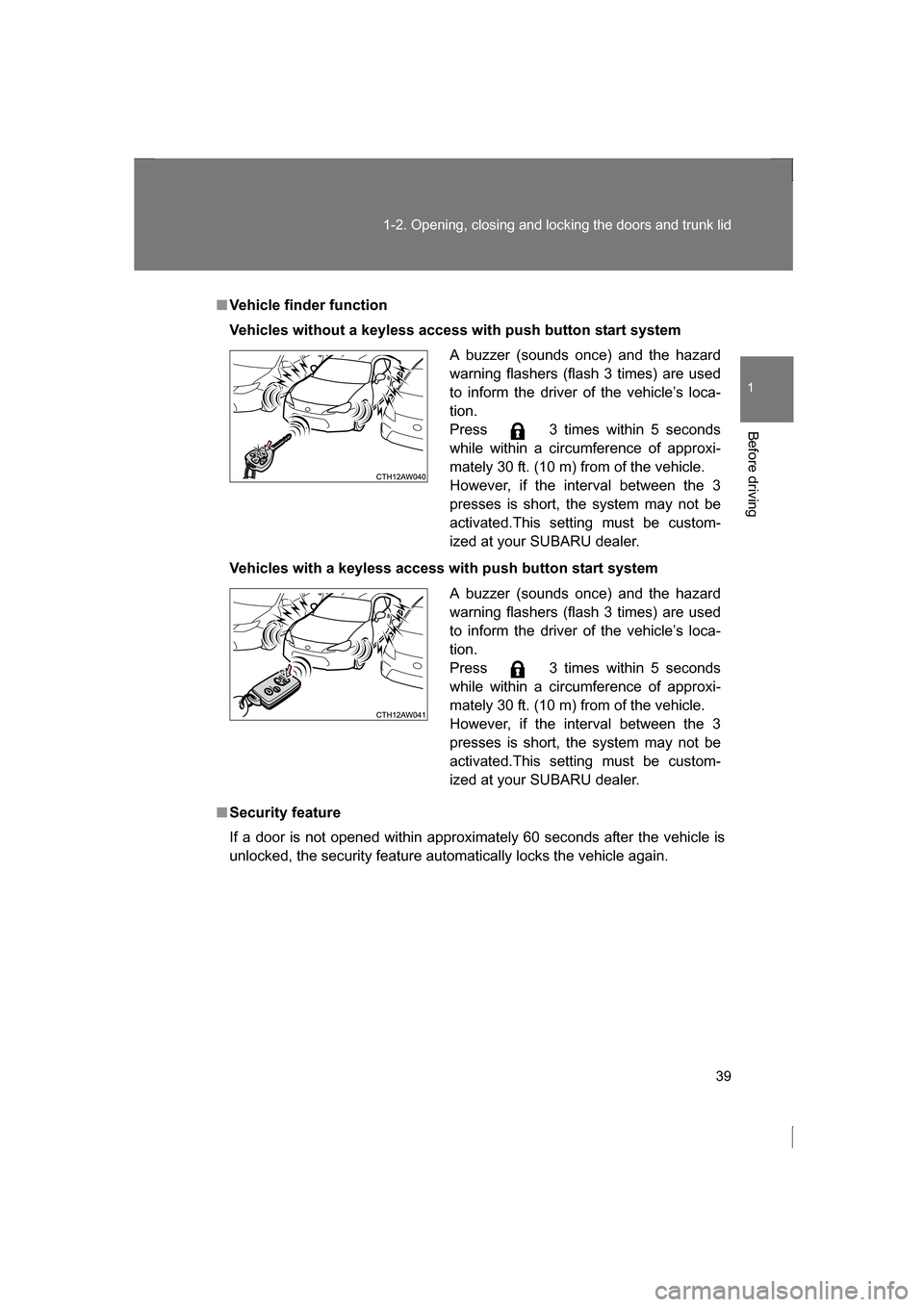
39
1-2. Opening, closing and locking the doors and trunk lid
1
Before driving
■Vehicle finder function
Vehicles without a keyless access with push button start system
Vehicles with a keyless access with push button start system
■Security feature
If a door is not opened within approximately 60 seconds after the vehicle is
unlocked, the security feature automatically locks the vehicle again.A buzzer (sounds once) and the hazard
warning flashers (flash 3 times) are used
to inform the driver of the vehicle’s loca-
tion.
Press 3 times within 5 seconds
while within a circumference of approxi-
mately 30 ft. (10 m) from of the vehicle.
However, if the interval between the 3
presses is short, the system may not be
activated.This setting must be custom-
ized at your SUBARU dealer.
A buzzer (sounds once) and the hazard
warning flashers (flash 3 times) are used
to inform the driver of the vehicle’s loca-
tion.
Press 3 times within 5 seconds
while within a circumference of approxi-
mately 30 ft. (10 m) from of the vehicle.
However, if the interval between the 3
presses is short, the system may not be
activated.This setting must be custom-
ized at your SUBARU dealer.
Page 41 of 484
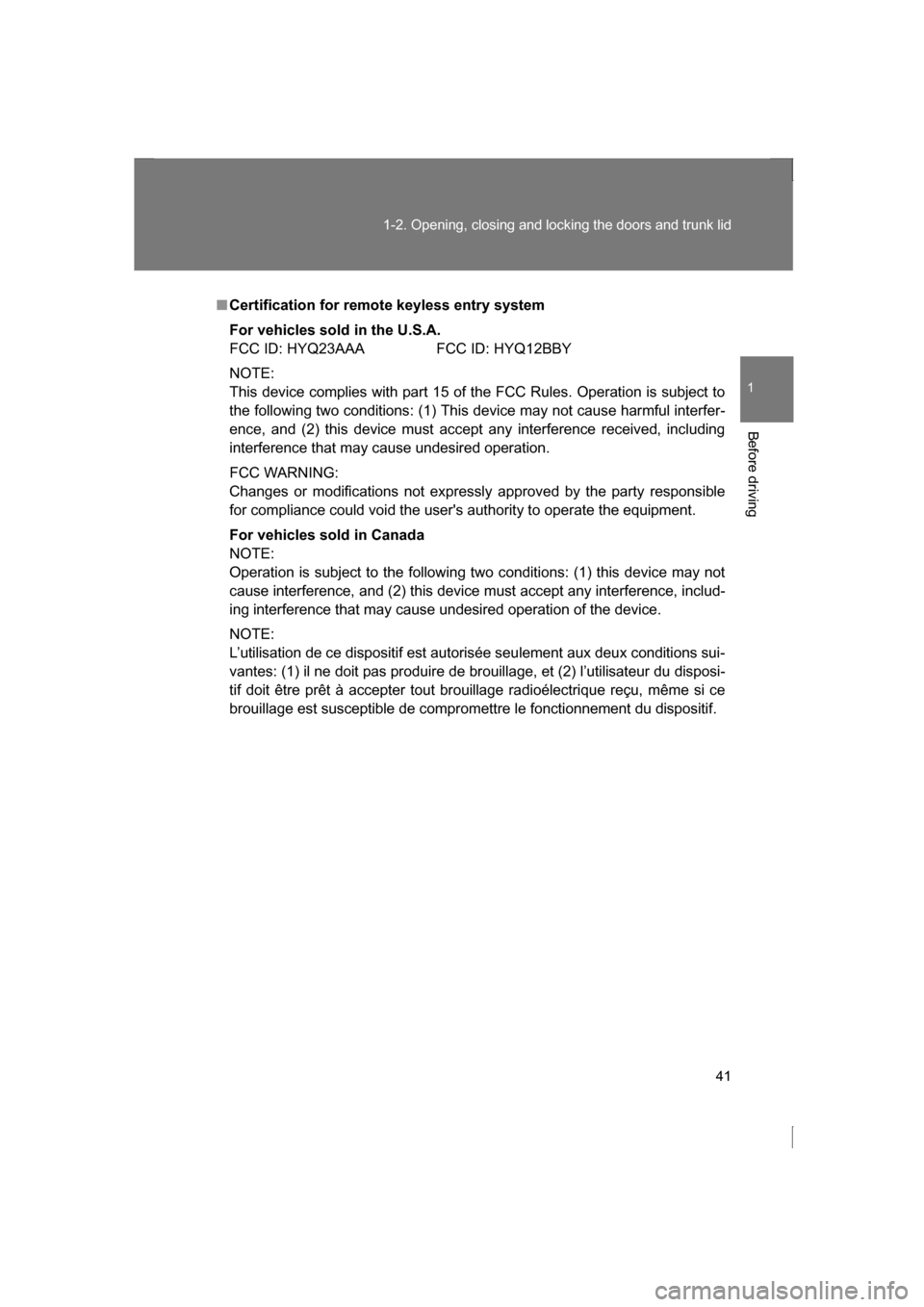
41
1-2. Opening, closing and locking the doors and trunk lid
1
Before driving
■Certification for remote keyless entry system
For vehicles sold in the U.S.A.
FCC ID: HYQ23AAA FCC ID: HYQ12BBY
NOTE:
This device complies with part 15 of the FCC Rules. Operation is subject to
the following two conditions: (1) This device may not cause harmful interfer-
ence, and (2) this device must accept any interference received, including
interference that may cause undesired operation.
FCC WARNING:
Changes or modifications not expressly approved by the party responsible
for compliance could void the user's authority to operate the equipment.
For vehicles sold in Canada
NOTE:
Operation is subject to the following two conditions: (1) this device may not
cause interference, and (2) this device must accept any interference, includ-
ing interference that may cause undesired operation of the device.
NOTE:
L’utilisation de ce dispositif est autorisée seulement aux deux conditions sui-
vantes: (1) il ne doit pas produire de brouillage, et (2) l’utilisateur du disposi-
tif doit être prêt à accepter tout brouillage radioélectrique reçu, même si ce
brouillage est susceptible de compromettre le fonctionnement du dispositif.
Page 44 of 484
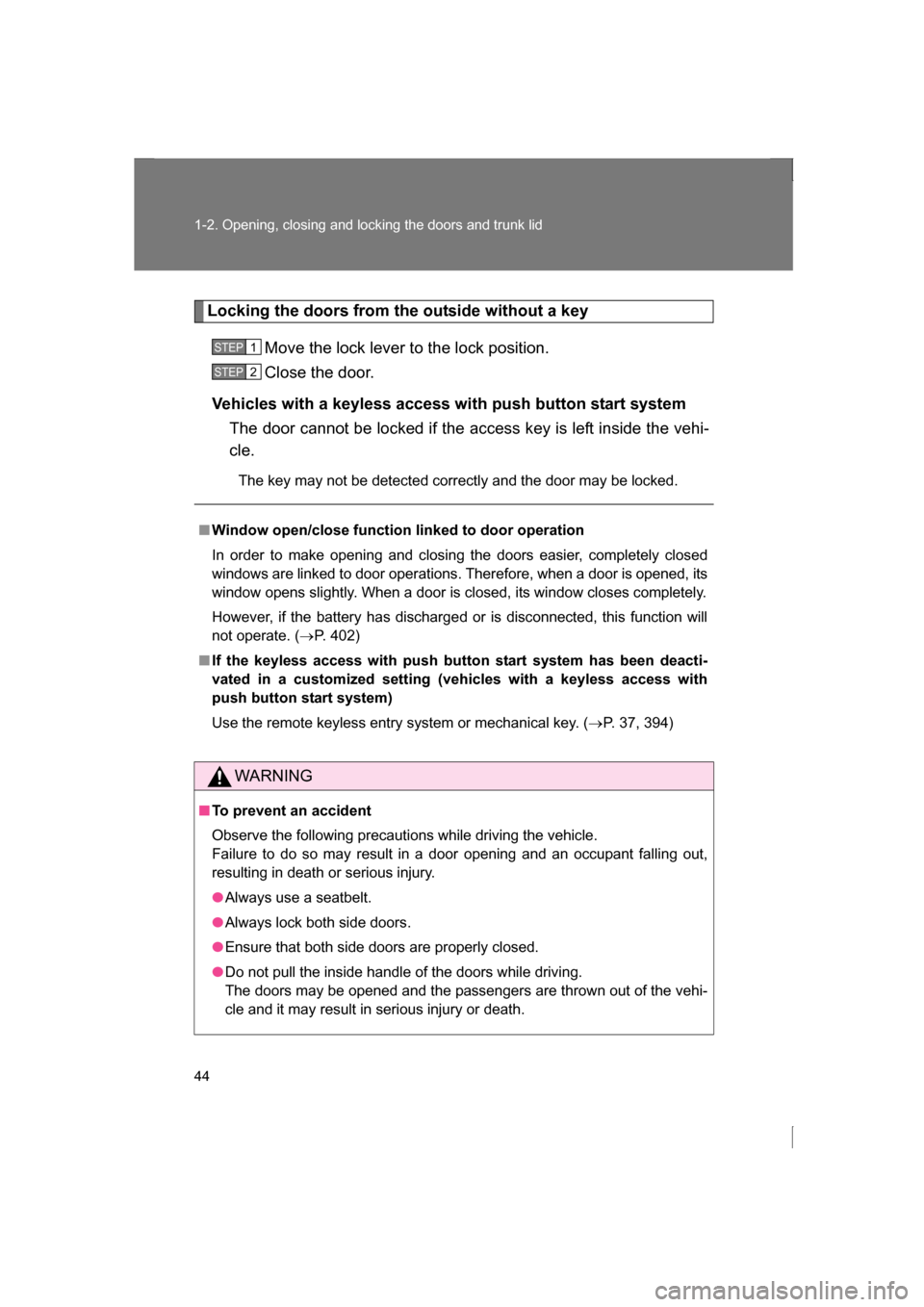
44
1-2. Opening, closing and locking the doors and trunk lid
Locking the doors from the outside without a keyMove the lock lever to the lock position.
Close the door.
Vehicles with a keyless access with push button start system The door cannot be locked if the access key is left inside the vehi-
cle.
The key may not be detected correctly and the door may be locked.
■Window open/close function linked to door operation
In order to make opening and closing the doors easier, completely closed
windows are linked to door operations. Therefore, when a door is opened, its
window opens slightly. When a door is closed, its window closes completely.
However, if the battery has discharged or is disconnected, this function will not operate. ( →P. 402)
■If the keyless access with push button start system has been deacti-
vated in a customized setting (vehicles with a keyless access with
push button start system)
Use the remote keyless entry system or mechanical key. ( →P. 37, 394)
WARNING
■To prevent an accident
Observe the following precautions while driving the vehicle.
Failure to do so may result in a door opening and an occupant falling out,
resulting in death or serious injury.
●Always use a seatbelt.
●Always lock both side doors.
●Ensure that both side doors are properly closed.
●Do not pull the inside handle of the doors while driving.
The doors may be opened and the passengers are thrown out of the vehi-
cle and it may result in serious injury or death.
STEP 1
STEP 2
Page 48 of 484
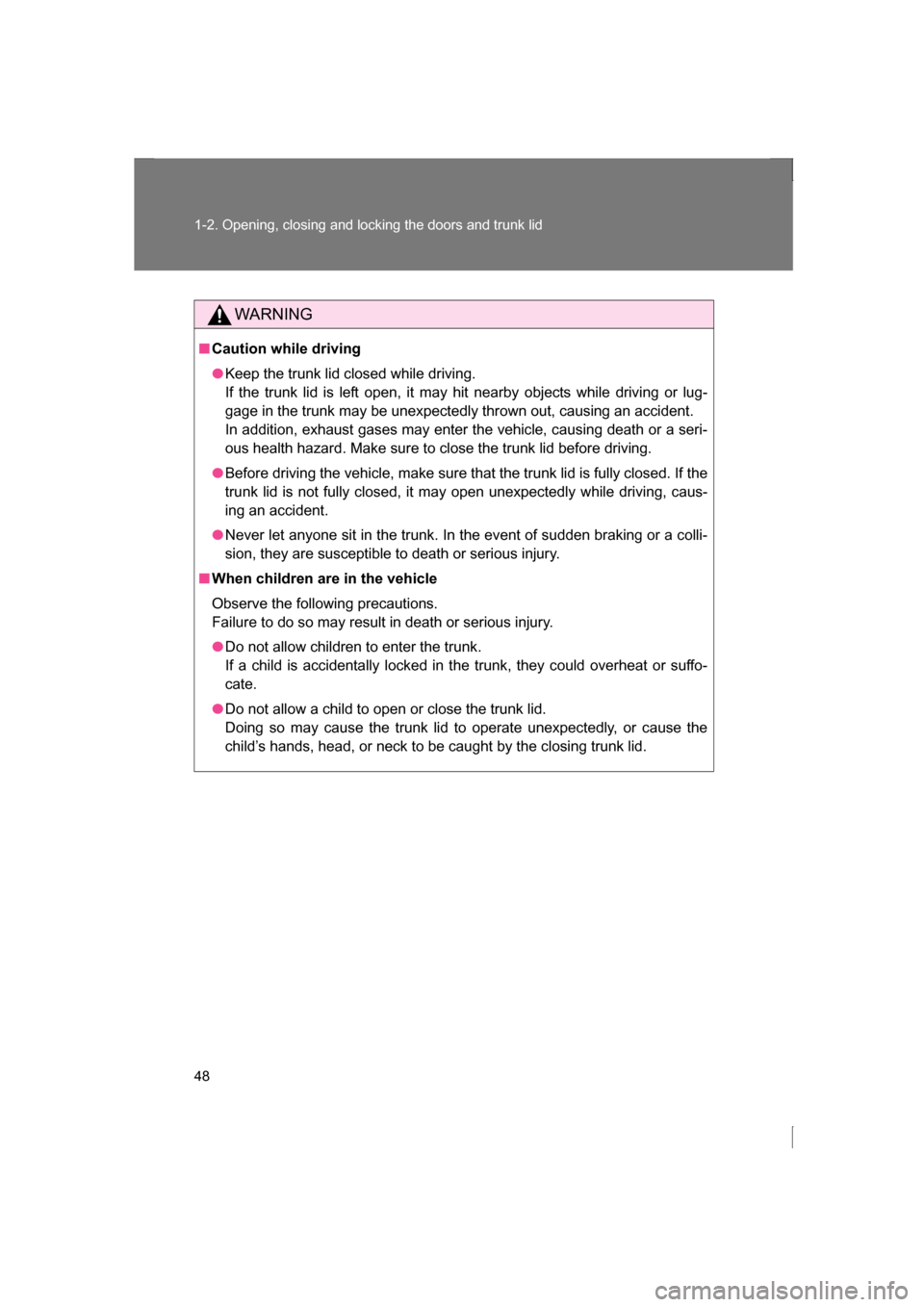
48
1-2. Opening, closing and locking the doors and trunk lid
WARNING
■Caution while driving
●Keep the trunk lid closed while driving.
If the trunk lid is left open, it may hit nearby objects while driving or lug-
gage in the trunk may be unexpectedly thrown out, causing an accident.
In addition, exhaust gases may enter the vehicle, causing death or a seri-
ous health hazard. Make sure to close the trunk lid before driving.
●Before driving the vehicle, make sure that the trunk lid is fully closed. If the
trunk lid is not fully closed, it may open unexpectedly while driving, caus-
ing an accident.
●Never let anyone sit in the trunk. In the event of sudden braking or a colli-
sion, they are susceptible to death or serious injury.
■When children are in the vehicle
Observe the following precautions.
Failure to do so may result in death or serious injury.
●Do not allow children to enter the trunk.
If a child is accidentally locked in the trunk, they could overheat or suffo-
cate.
●Do not allow a child to open or close the trunk lid.
Doing so may cause the trunk lid to operate unexpectedly, or cause the
child’s hands, head, or neck to be caught by the closing trunk lid.
Page 49 of 484
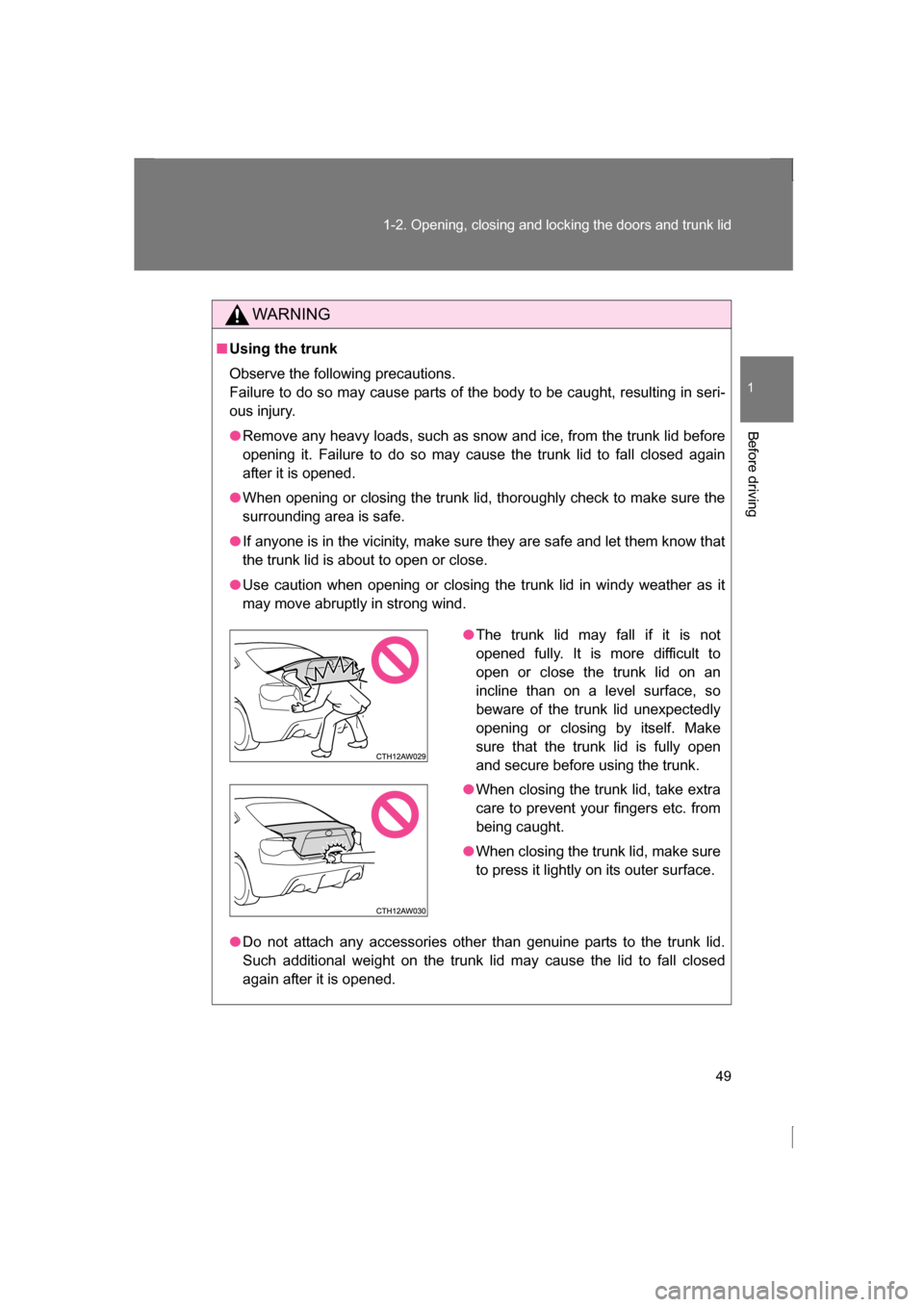
49
1-2. Opening, closing and locking the doors and trunk lid
1
Before driving
WARNING
■Using the trunk
Observe the following precautions.
Failure to do so may cause parts of the body to be caught, resulting in seri-
ous injury.
●Remove any heavy loads, such as snow and ice, from the trunk lid before
opening it. Failure to do so may cause the trunk lid to fall closed again
after it is opened.
●When opening or closing the trunk lid, thoroughly check to make sure the
surrounding area is safe.
●If anyone is in the vicinity, make sure they are safe and let them know that
the trunk lid is about to open or close.
●Use caution when opening or closing the trunk lid in windy weather as it
may move abruptly in strong wind.
●Do not attach any accessories other than genuine parts to the trunk lid.
Such additional weight on the trunk lid may cause the lid to fall closed
again after it is opened.
●The trunk lid may fall if it is not
opened fully. It is more difficult to
open or close the trunk lid on an
incline than on a level surface, so
beware of the trunk lid unexpectedly
opening or closing by itself. Make
sure that the trunk lid is fully open
and secure before using the trunk.
●When closing the trunk lid, take extra
care to prevent your fingers etc. from
being caught.
●When closing the trunk lid, make sure
to press it lightly on its outer surface.
Page 52 of 484
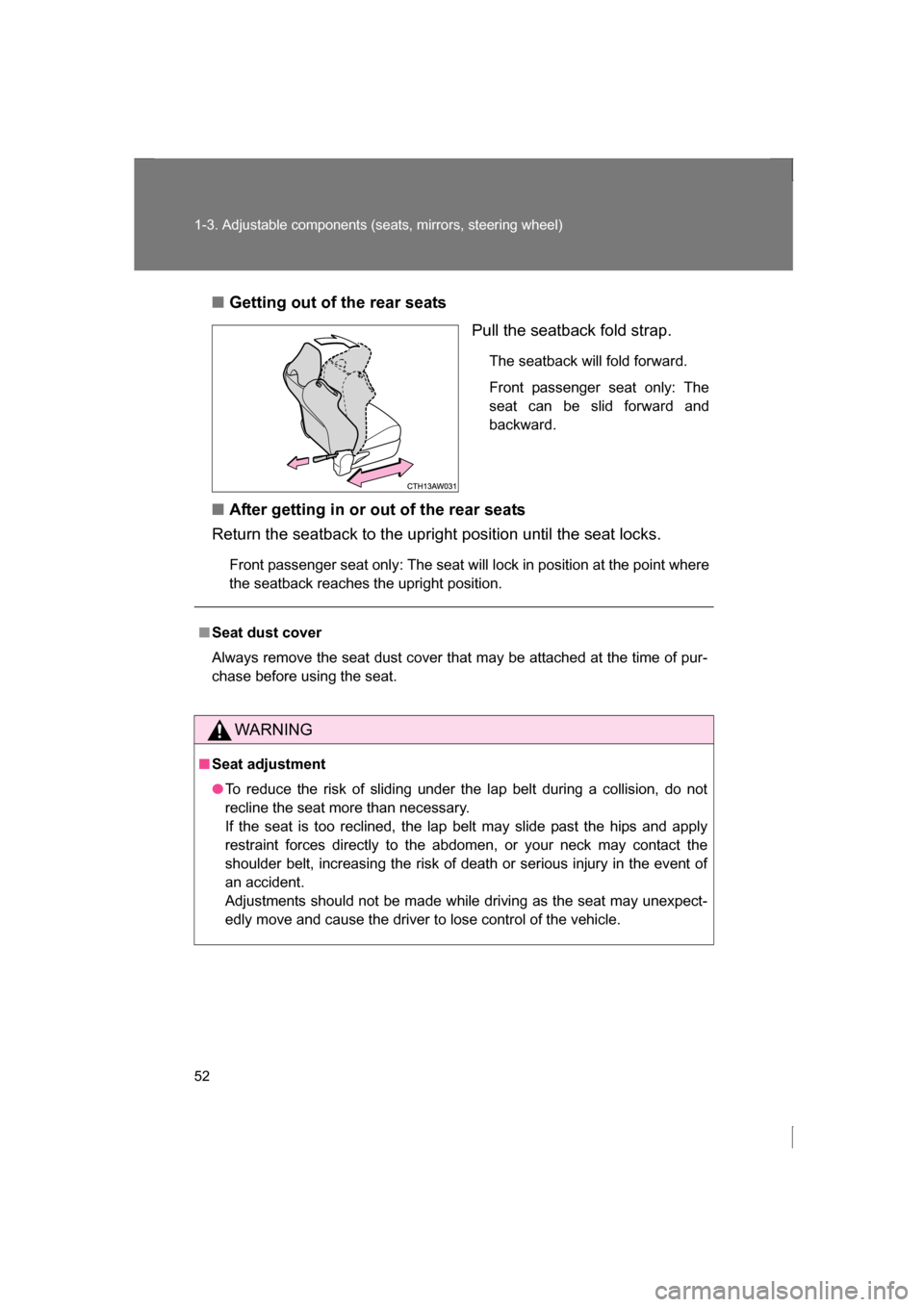
52
1-3. Adjustable components (seats, mirrors, steering wheel)
■Getting out of the rear seatsPull the seatback fold strap.
The seatback will fold forward.
Front passenger seat only: The
seat can be slid forward and
backward.
■After getting in or out of the rear seats
Return the seatback to the upright position until the seat locks.
Front passenger seat only: The seat will lock in position at the point where
the seatback reaches the upright position.
■Seat dust cover
Always remove the seat dust cover that may be attached at the time of pur-
chase before using the seat.
WARNING
■Seat adjustment
●To reduce the risk of sliding under the lap belt during a collision, do not
recline the seat more than necessary.
If the seat is too reclined, the lap belt may slide past the hips and apply
restraint forces directly to the abdomen, or your neck may contact the
shoulder belt, increasing the risk of death or serious injury in the event of
an accident.
Adjustments should not be made while driving as the seat may unexpect-
edly move and cause the driver to lose control of the vehicle.
Page 53 of 484
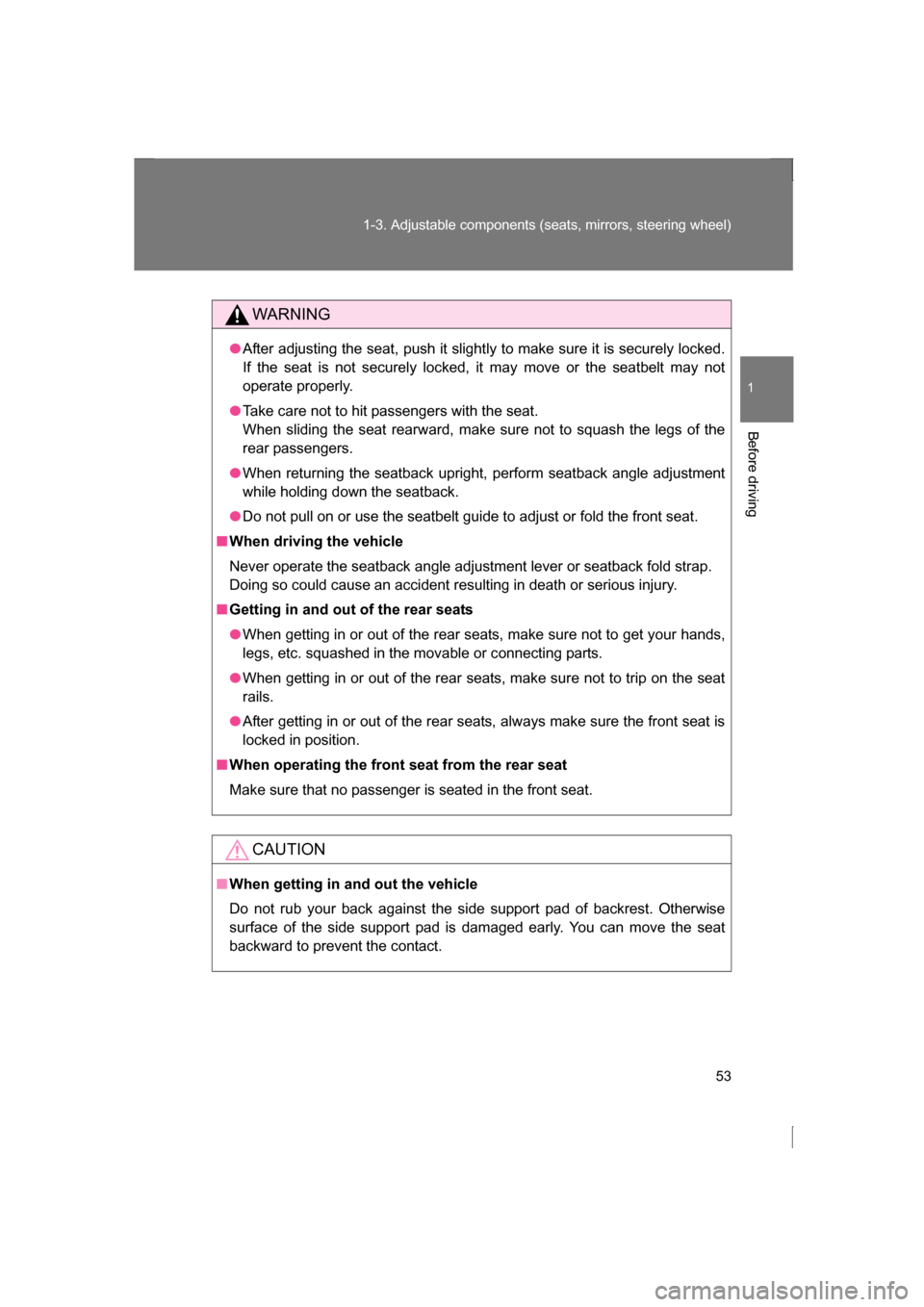
53
1-3. Adjustable components (seats, mirrors, steering wheel)
1
Before driving
WARNING
●After adjusting the seat, push it slightly to make sure it is securely locked.
If the seat is not securely locked, it may move or the seatbelt may not
operate properly.
●Take care not to hit passengers with the seat.
When sliding the seat rearward, make sure not to squash the legs of the
rear passengers.
●When returning the seatback upright, perform seatback angle adjustment
while holding down the seatback.
●Do not pull on or use the seatbelt guide to adjust or fold the front seat.
■When driving the vehicle
Never operate the seatback angle adjustment lever or seatback fold strap.
Doing so could cause an accident resulting in death or serious injury.
■Getting in and out of the rear seats
●When getting in or out of the rear seats, make sure not to get your hands,
legs, etc. squashed in the movable or connecting parts.
●When getting in or out of the rear seats, make sure not to trip on the seat
rails.
●After getting in or out of the rear seats, always make sure the front seat is
locked in position.
■When operating the front seat from the rear seat
Make sure that no passenger is seated in the front seat.
CAUTION
■When getting in and out the vehicle
Do not rub your back against the side support pad of backrest. Otherwise
surface of the side support pad is damaged early. You can move the seat
backward to prevent the contact.